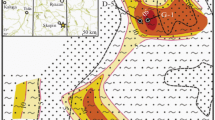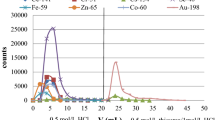Abstract
A procedure has been developed for the determination of 39 elements in a single sample of rock or mineral by neutron activation analysis. After the sample has been irradiated with neutrons, it is separated chemically into 12 groups for radioassay with one NaI(Tl) and two Ge(Li) detectors. Three chemists can complete the separations and sample preparations within 7 hrs after the end of the neutron irradiation. Carrier is added and a chemical yield is determined for each element. About two months are required to obtain complete data for a particular sample, but several samples can be analyzed concurrently. In a sample of typical igneous material weighing 0.5 g, half of the elements can be determined to better than ±5 per cent precision and accuracy, and fewer than a fifth with precision and accuracy poorer than ±25 per cent.
Similar content being viewed by others
References
G. E. Gordon, K. Randle, G. G. Goles, J. B. Corliss, M. H. Beeson, S. S. Oxley Geochim. Cosmochim. Acta, 32 (1968) 369.
D. R. Case, J. C. Laul, M. A. Wechter, F. Schmidt-Bleek, M. E. Lipschutz, Modern Trends in Activation Analysis, Vol. 1, U. S. Government Printing, Office, Washington D. C., 1969, p. 409.
K. Tomura, H. Higuchi, N. Miyaji, N. Onuma, H. Hamaguchi,Anal. Chim. Acta, 41 (1968) 217.
J. C. Cobb,Anal. Chem., 39 (1967) 127.
R. H. Filby, W. A. Haller, Modern Trends in Activation Analysis, Vol. 1, U.S. Government Printing Office, Washington, D. C., 1969, p. 339.
G. H. Morrison, J. T. Gerard, A. Traveri, R. L. Currie, S. F. Peterson, N. M. Potter,Anal. Chem., 41 (1969) 1633.
O. Landstrom, K. Samsahl, C. G. Wenner, Modern Trends in Activation Analysis, Vol. 1, U. S. Government Printing Office, Washington, D. C., 1969, p. 353.
F. J. Welcher, The Analytical Uses of Ethylenediaminetetraacetic Acid, Van Nostrand, Princeton, N. J., 1958.
H. A. Flaschka, EDTA Titrations: An Introduction to Theory and Practice, Pergamon, New York, 1959.
R. O. Allen, Multi-element Neutron Activation Analysis: Development and Application to a Trace Element Study of the Bruderheim Chondrite, Ph. D. Thesis, University of Wisconsin, Madison, 1970.
L. A. Haskin, R. O. Allen, P. A. Helmke, T. P. Paster, M. R. Anderson, R. L. Korotev, K. A. Zweifel, Proc. Apollo, 11 Lunar Sci. Conf. (A. A. Levinson Ed.) Vol. 2, Pergamon, New York, 1970, p. 1213.
E. B. Denechaud, P. A. Helmke, L. A. Haskin,J. Radioanal. Chem., 6 (1970) 97.
H. R. Lukens, Jr., GA-5073, 1964.
F. J. Flanagan,Geochim. Cosmochim. Acta,31 (1967) 289.
See the series of articles on trace elements in Apollo 11 returned Lunar samples,Science, 167 (1970) 485.
Author information
Authors and Affiliations
Rights and permissions
About this article
Cite this article
Allen, R.O., Haskin, L.A., Anderson, M.R. et al. Neutron activation analysis for 39 elements in small or precious geologic samples. J. Radioanal. Chem. 6, 115–137 (1970). https://doi.org/10.1007/BF02513905
Received:
Issue Date:
DOI: https://doi.org/10.1007/BF02513905




